#quercus virginiana
Text

#snow#photography#original photography#nature photography#photographers on tumblr#original photographers#snow on trees#quercus virginiana#live oak#winter photography
7 notes
·
View notes
Text
Kairiz "helping" me take pictures of seeds I collected
Jumping up onto the couch right as I took a picture with flash on:
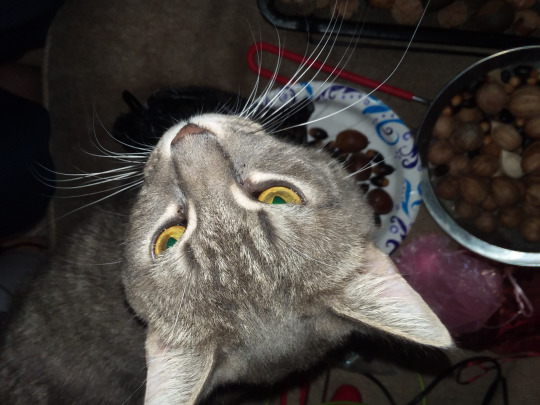
[ID: A flash photo of a grey cat tilting his head back to look up at the camera, his eyes reflecting bright yellow with green pupils. Below him in the shadowy background are plates and baskets with various acorns and nuts on them. End ID.]
Deciding he wants the exact acorn I am holding right as I take the picture:

[ID: A photo of a white hand holding four types of acorns: Live oak, which is the smallest, being long and skinny, with a shiny black shell that is tan where the cap was. Shumard oak, which is large and boxy, brown, and covered with a light grey dusting. Swamp chestnut oak, which is the largest, shiny deep brown, tall and fat. And overcup oak, which is round, and still covered by its thin, bumpy cap. A grey cat's paw is dragging the overcup acorn off the hand, claws extended to catch onto the cap. End ID.]
And sticking his face directly in the way:

[ID: A flash photo of the back of a grey cat's head as he sniffs a purple organza bag filled with large dark acorns, blocking most of the view with his head and ears. End ID.]
outdoor cat people DNI, you'll just be blocked. We care about pets and the environment here, honoric of your choice. Keeping cats outdoors is animal abuse and causing more native species to go extinct.
Keep your cats inside so they can "help" you catalogue the different species in your area by playing with everything you bring home, instead of bringing you dead native birds.
#Kairiz the cat#cats#described images#southern live oak#Quercus virginiana#WHIC IS A RIP OFF NAME!!!#Shumard oak#Quercus shumardii#at least makes sense#Swamp chestnut oak#Quercus michauxii#I assume that was named after whoever described it#Overcup oak#Quercus lyrata#that's a pretty name#oaks#acorns#iNaturalist#Rjalker does iNaturalist#long post
5 notes
·
View notes
Text

Buy Good Quality Quercus Virginiana Trees
If you want to buy the best quality Quercus Virginiana trees for your landscape projects, then visit TreeWorld Wholesale, we offer healthy plants & trees. We have a wide variety of Quercus Virginiana (Southern live oak) trees. Quercus Virginiana (Southern live oak) is a signature tree of the traditional southern plantation house. For more details, visit our website.
0 notes
Photo

Quercus virginiana
Middleton Place. Charleston, SC. July 2013. Photo by M. Lucero.
#charleston#south carolina#sc#middleton place#plantation#lowcountry#live oak#quercus virginiana#resurrection fern#spanish moss#southern#photo#photography#photographers on tumblr#photography on tumblr#2013#original photography
1 note
·
View note
Text
I feel like there's gonna be a really obvious answer to this, but I've started wondering why so many Carolinian plants are named after Virginia (i.e. Virginia waterleaf, southern live oak/Quercus virginiana, Virginia mountain mint, etc). There's even a Wikipedia page dedicated to "shit that has virginana as a scientific name." Do they have more naturalists there? Is it just that it sounds like a better name than, like, ontarioensis?
#which to be fair does not sound great#plant tag#... what tags do NA native plant people follow? i really do want an answer
56 notes
·
View notes
Text
Untitled Wednesday Library Series, Part 132
Forest Trees of the United States and Canada, and How to Identify Them is a deceivingly sparse little thing. Elbert L. Little, Jr., formerly Chief Dendrologist for Timber Management Research in the United States Forest Service, took 30 years to go from semi-internal articles to this book. Presumably there was a lot of editing and updating. I don’t know; I only have the final product, or rather a post-final version — this is a cheaply made 1979 Dover edition after the ‘original’ 1978 Important Forest Trees of the United States.



The How
Alike to Pt. 128. Hell yeah, etc.
The Text
204 tree species (native and non-, for certain values of each) of the titular countries, which mandate is taken to include Hawaiʻi, Puerto Rico, and the U.S. Virgin Islands. It’s a tall order for a botanical text — much less a forestry one — to let the biogeographical out from under the biopolitical, but this is pretty on the nose.
Line drawings of leaves and distinctive fruits or flowers, maps, and quick keys for hasty IDs, all roughly divided by region and taxonomic relationships. More or less straightforward and neatly condensed from larger works; basically pretty successful on its own terms.


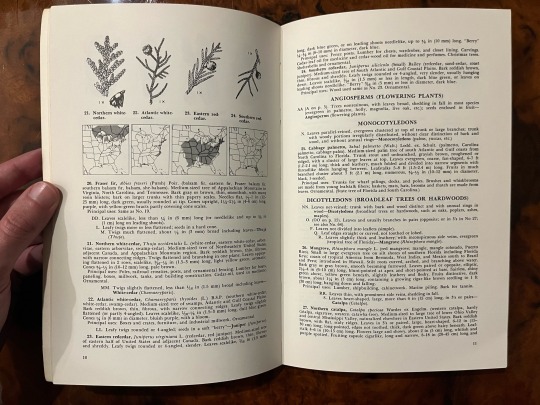
But hark! My two best friends, Texas live oak Quercus fusiformis and Ashe juniper Juniperus Ashei, are disrespected. The former is lumped in with Q. virginiana’s range; the latter is passed over completely. Fie and fuck off.
The Object
Solidly bound given its design; nicely rendered given its size; neatly illustrated within, as far as I can tell, by the author. Paul E. Kennedy’s cover design may not make it, per se, but it doesn’t hurt. Unquestionably a late-70s Dover joint.
According to the name inside, this copy belonged to a local who died in 2012. It never got processed into any institutional collection, despite where we found it — probably a perpetual discard.
The Why, Though?
Of the two tree books I’ve picked up recently, this is the less favorite. We’ll see the other one before long (health and Wednesdays permitting), but there’s space for both — even with all my getting-better-at-knowing-plants-sometimes, trees are a bit of a lacuna. That’s doubly true now that I’ve left my comfort region behind; the more help the merrier.
17 notes
·
View notes
Note
plant meanings!!!! ramble about em!!!!!! I wanna hear it!!!!
he he :3
plants! technically spoilers for the fic i just posted the vine that ate the south, so like, yknow. under the cut!
alright so! i spent. do not even want to know how long to come up with all of these. from the start i knew leafpool was gonna be kudzu and since (as probably is obvious from the title) the idea of kudzu growing over and smothering everything is strongly associated with the american south, the clans are vaguely set there! somewhere in the georgia-alabama area idk. so all my plants. should grow there lol.
and now to copy paste my notes! anything added i'll put in (parenthesis) at the end.
Leafpool: Kudzu (Pueraria montana), smothering imagery—she is smothered and left to die by starclan.
Squirrelflight: The wild strawberry (Fragaria virginiana). There is something to this idea of always being this provider, and how that is taken from her, ex. how this is one of the parents of the cultivated strawberry. Also straw is similar to star <3. (i'll add--literally i just liked the vibes of this also, i tried finding something else but just kept coming back squilf being a strawberry <3)
Mothwing: While she doesn’t actually have a daemon, to hide that she weaves long-spurred violets (Viola rostrata) into her fur, because violets are lesbian flowers and also because they tend to grow near eastern hemlock trees…so, connecting her to Leafpool! (ie. to the forest, aka where leaf is from) Before her brother’s death, however, she wore aconite (Aconitum lycoctonum,)the specific species of which is non-native but grown in gardens in the Americas, and less toxic than some other varieties, so she gets the benefits of not being doubted (who would wear actual toxin in their fur) without like. dying lol.
Hollyleaf: Wood Lily (Lilium philadelphicum) as they’re poisonous to cats and thus get that association, but also in looks you could see them as a star—but not an aster species. She’s the odd one out.
Jayfeather: Georgia aster (Symphyotrichum georgianum). It’s a rather rare species that used to be far more common as it depends on wildfire-made environments and thus occupies a far smaller range than it once did, like how Jay is sort of hemmed in and stuck by the clan system lol.
Lionblaze: Calico aster (Symphyotrichum lateriflorum). It’s a pretty common aster species with a wide range and it grows in tandem with other aster species—I write Lion as a pretty family-oriented guy so it fits.
and though she was cut from the fic dovewing would have both kudzu (to connect her w/ leaf, and very much show how starclan is now forcing dove to the prophecy and basically stuff i wrote in flightless dove) and Aster quitensis, which is a rare and maybe extinct aster species that is only found in ecuador. my notes here just say "she is not getting out of this alive" so take that as you will.
and for the minor characters who i gave plants...
Cinderpelt: Woodland Sunflower (Helianthus divaricatus) just. Because I feel like it fits her okay. cheerful despite her circumstances, happy to be here, taking it one day at a time.
Brambleclaw: Carolina Rose (Rosa carolina) because. C’mon. The thorns. The association with love. He’s toxic as get out. The story isn’t about that but it COULD BE. (brambleclaw was going to play a larger role but the fic turned way deeper into leaf being the mother of hollyjaylion than i thought it would be so he mostly got cut.)
Firestar: Southern Live Oak (Quercus virginiana), because it's a large tree that works with Thunderclan being The Forest, and also they're like, almost evergreen--they keep their leaves year-round mostly and Thunderclan would like that!
annnnnd that's my plants! wahoo!
8 notes
·
View notes
Text
The Angel Oak, a 500 year old Southern Live Oak (Quercus Virginiana).
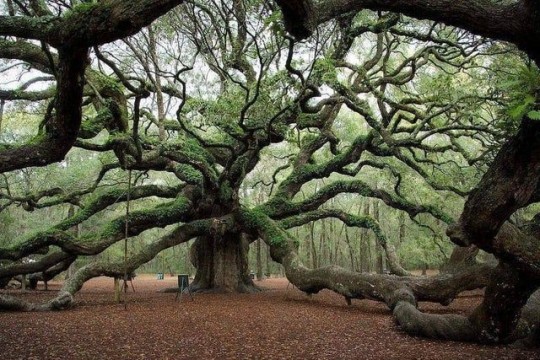
10 notes
·
View notes
Text

#CuriositiesFromTheWorld
What numbers, this tree!
It is called Angel Oak ("Angel Oak"), it is a multi-hundred-year-old specimen of Quercus virginiana found in Charleston, in the American state of South Carolina.
Its estimated age is between 400 and 500 years, its height is 20 meters and its foliage occupies an area of approximately 1,600 square meters.
The longest of its winding branches measures 57 meters.
Source 👉 #Focus
#CuriositàDalMondo
Che numeri, questo albero!
Si chiama Angel Oak ("Quercia dell'angelo"), è un esemplare di Quercus virginiana pluricentenario che si trova a Charleston, nello stato americano della Carolina del Sud.
La sua età stimata è tra i 400 e i 500 anni, la sua altezza 20 metri e la sua chioma occupa una superficie di circa 1.600 metri quadrati. Il più lungo dei suoi tortuosi rami misura 57 metri.
Fonte 👉 #Focus
0 notes
Text
Igniting Writing ‘Families and Friendships’ Contest 2023, Submission by Aisha
Greeting her woodland friends, Dryope soared through the sky and took in the never-ending view of the lush, viridescent plains, the snow on the mountains glistening like hidden gems in the sunlight. She had almost reached the lakes when, with a swoop of her stomach, she halted, remembering that she could not stray too far from her kin, the Quercus Virginiana; otherwise, as she jokingly and lovingly liked to call it, ‘mea mollitia’, which was Latin for ‘my resilience’.
That oak tree was Dryope’s patient soulmate; while she was an eagle soaring through skies with constant curiosity, it remained firm in its everlasting position, watching her fondly as she did somersaults in the sky in delight. And as the lively days turned to star-studded nights, Dryope would return to her mea mollitia, settling delicately on one of its large branches and confiding passionately in her precious tree. Its leaves would rustle in agreement and grow silent just to listen.
It felt wonderful just to connect and bond with her lifelong comrade. As a dryad, the young nymph could not stray too far away from her tree, otherwise the chances that she would meet her inevitable end would heighten rapidly. That was what she was taught by her family anyway.
And as much Dryope loved her dear tree, she was tired of seeing the same sights that her home plains had to offer. The tired beauty of the seeming endlessness of nature did not bring her the delight that it used to and Dryope was eager, desperate, to experience something different.
Stroking her long golden tresses absentmindedly, Dryope knew her internal conflict about the matter was the only thing that she would keep from her precious tree… for a while at least.
#writing group#igniting writing#creative writing#writing for teens#writing club#teen writers#writing challenge#writing competition#writing contest#library
0 notes
Text


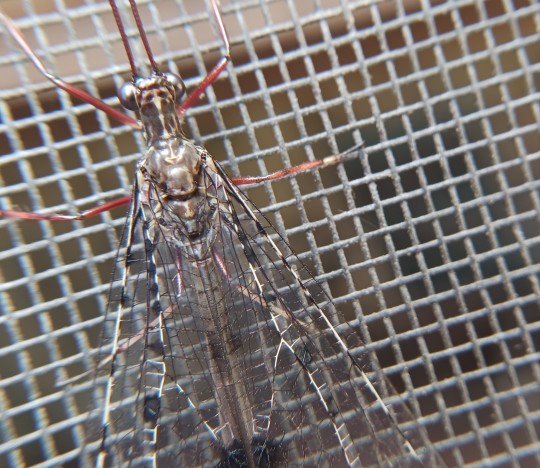

omg I feel so silly because of how long it took me to identify this insect, I took this photo two weeks ago. T_T
The species is Glenurus gratus (AKA: doodlebugs and 'demons of the dust'). It's an antlion, within the order Neuroptera. Both adults and larvae are predators.
My mistake when I was identifying this one was that I thought it was a damselfly T_T
side tangent: I got orders Odonata and Neuroptera confused because they both have similar wing shapes and long thin bodies (and idk what im doing lol). However, you can tell them apart by resting wing placement: (with some exceptions) dragonflies fold their wings straight up over their backs, damselflies hold their wings straight out, and antlions fold their wings down at 45-degree angles.
the color though is really beautiful and distinct. The tips of the wings look like strawberry milk 🥛 🍓 also they are often found on southern live oaks (Quercus virginiana)!! Combining my love for tree and bug ID <3
I used the University of Florida's entomology website to source most of my information, as well wikipedia (lol) and bug-guide.
#im actually not too sure about the species because its a little northern than what it says on the internet#but im pretty confident about the genus#entomology#insect#neuroptera#doodlebugs#antlions#who even knows#also i just learned that antlion is literally ANT LION! BECAUSE THEY EAT ANTS#SKKSKSKSJJS#IM SO DUMB LMAOO
0 notes
Text
this is the most disappointing picture I've ever taken
A wasp was sitting on the acorn drinking out of the cap not even a second before I took this picture. It flew away completely before my thumb hit the camera button. RIP.
but anyways look at that wasp gall next to the cap, it's the little brown sphere on the bottom of the leaf, probably the species Belonocnema treatae, which doesn't have a common name.
This is a southern live oak tree, which is evergreen! It's weird. The acorns when ripe are a very shiny black, with a noticeable "tan line" where the cap was, which stays pale tan. It's a host plant for multiple species of gall wasps, including Belonocnema treatae, but also:
Callirhytis quercusbatatoides, aptly named the Southern Live Oak Stem Gall Wasp, because it forms galls on the stem rather than the leaves.
There's also Andricus quercusfoliatus, the Leafy Oak Gall Wasp, which also forms galls on the stems, but they almost look like fluffy acorn caps, and the first few times I saw them, I thought they /were/ developing acorns!

[ID: A portrait photograph of a southern live oak tree, with an empty acorn cap facing the camera that has a few drops of water in it. Below and around it are unripe acorns still in their caps, which are dark green on the ends and paler green towards the cap.
The leaves of the live oak are dark green, and shaped long long ovals, with slightly wavy edges. The stems are light tan, with clusters of red pointed buds at the end of each twigs. Some spanish moss, with strands of fuzzy light grey, curl around the twigs and a dead branch.
Next to the acorn cap in the center of the photo, on a leaf behind it, is small, red-brown sphere of a wasp gall from the species Belonocnema treatae.
Some sparce grass and dead leaves are visible on the ground in the background
End ID.]
#Rjalker takes pictures#southern live oak#quercus virginiana#live oak#live oaks#oaks#acorns#spanish moss#wasp galls#gall wasps#?#Belonocnema treatae#galls#oak galls
3 notes
·
View notes
Text
issuu
Growing Quercus Virginiana Trees To Your Landscape
A Quercus virginiana (commonly known as the live oak) is a fast-growing shade tree that can reach an average height of 35 to 60 feet and live an average of 200 years, depending on where it’s planted. Continue Reading>>https://issuu.com/treeworld/docs/the_secrets_to_successfully_planting_a_quercus_vir.
0 notes
Text
Starts and Moves, 2023/07/01-2023/07/07
quercus virginiana does not care what you think
I gave my brain a break. All the thinking I’ve done or been capable of doing for the last week is below; the rest is skateboard and pretty colors. Lo, how art the mighty fallen, etc etc, but I think I’m significantly happier as a shabby gym rat than I ever was as an attempted aesthete. I certainly have more fun.
Want to read these as they come out? Become a patron!
Grian Chatten, “Chaos for the…
View On WordPress
#Do Nothing#Hand Habits#Heavy Rotation#Liv.E#music discovery#now playing#snake eyes#Starts and Moves#streaming
0 notes
Text
GROUNDWATER CLASSIFICATION EXCEPTION
“Drainage ditch” is too vulgar a term for the narrow creek that ran through the fenced off little park twenty yards behind the last condo before we left.
It was good to be near it. I think all running water is like that, even that small amount of it-- at the narrowest part a child could jump across, and I did, when I was eight or nine and we lived another few streets down from the place.
My grandma called it a “babbling brook.” This is still how I think of it: the water running fast enough at the narrow parts that it made the pleasant sound you can hear recorded on relaxation CDs buried in the bottom of a box in your storage closet.
Where the stream widened at the end of the park, though, it pooled shallow and near-stagnant among a patch of cattails and other wet reedy plants. There was always garbage in the water. I never thought of it as dirty, only invasive. It was just as much a part of the environment as the fauna: here was the forsythia (Forsythia suspensa), and the juniper trees (Juniperus virginiana), and here the empty half-liter soda bottle (polyethylene terephthalate).
And that time I ran back to what I knew as home, along the sidewalk that flanked Blue Spring and then the asphalt, and cut through the grassy hill behind the townhouses to get to the one that was mine. (The back door would have been closer, but we did not use that door.)
The beads of granular lawn herbicide (2,4-dichlorophenoxyacetic acid, 3,6-dichloro-2-methoxybenzoic acid) embedded in the soles of my shoes meant that I was to leave them outside today on the porch. In my sock feet I went inside only to get a Shoprite bag (HDPE) to stuff in my pocket to bring back with me, and back on the porch I put my shoes on one at a time without untying them. The stick that I used to fish the empty cigarette box (LDPE and paper) from the water had only recently snapped from the pin oak (Quercus palustris) that stood tall above this park. The park he now stood in, of course, was neither public nor more than an acre and a half; he judged that harshly.
I characterized him alternately as watching over the goings-on in this neighborhood with a silent protectiveness and as too old and tired to see the scrubby pines and patches of clover as anything but pathetically little consolation for what used to be here.
He had been here before they had put these houses up, I was sure of it. The townhome I lived in as a child was built in 2001. The last one I lived in before I left the state was built in 1992, and failing in dozens of small insidious ways that pooled in the sump much faster than the pathetic battery backups (lead dioxide, sulfuric acid) stacked in the basement closet could handle. Security theater was unconvincing to the driving weight of the water.
The pin oak, which I would guess had stood there since the 1960s, would stand for fifty years more unless someone came to destroy it. He did watch, I knew, as the condos in the long gray buildings across the street settled down to piecemeal destroy themselves.
I took the cigarette box in my ungloved hand from the end of my fishing-stick and put them in the bag and then I did not think about what my mother’s reaction might be. I often thought of it before I did things; that day I did not.
And hence I filled the bag with invasive treasures: three-quarters of a faded water bottle label (polypropylene), an empty chip bag (oriented polypropylene), a small chunk of styrofoam (polystyrene).
I pulled the bag into a tight knot at the top, and down from my small fingertips to my elbow ran the freed little rivulet of water (water, trichloroethylene, 1,1-dichloroethene).
1 note
·
View note
Text
Untitled Wednesday Library Series, Part 91
I do not know how I found the time and focus to read for pleasure these last few weeks. The thing nobody tells you about grad school and work and real life is that it’s all quite time consuming, actually. Whether I should’ve been reading this is apart from the point; I did do, and now I get to talk about it.
It: Live Oaking: Southern Timber for Tall Ships. First published in 1981 by Northeastern University Press; this, a copy from the second run, belongs to the 1995 Naval Institute Press edition. Our author is, incredibly, Virginia Steele Wood.
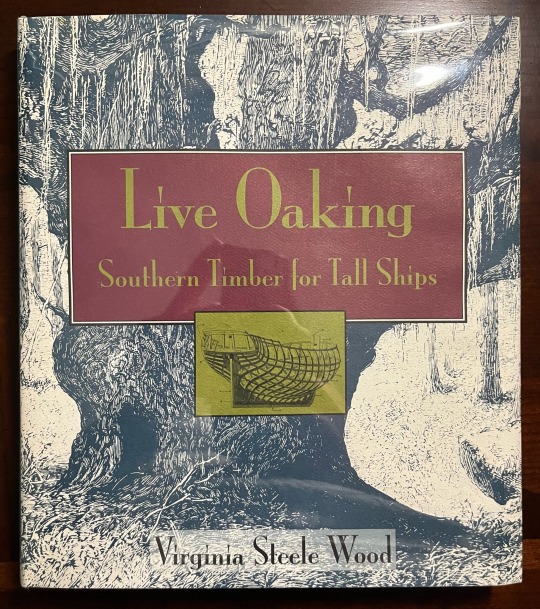
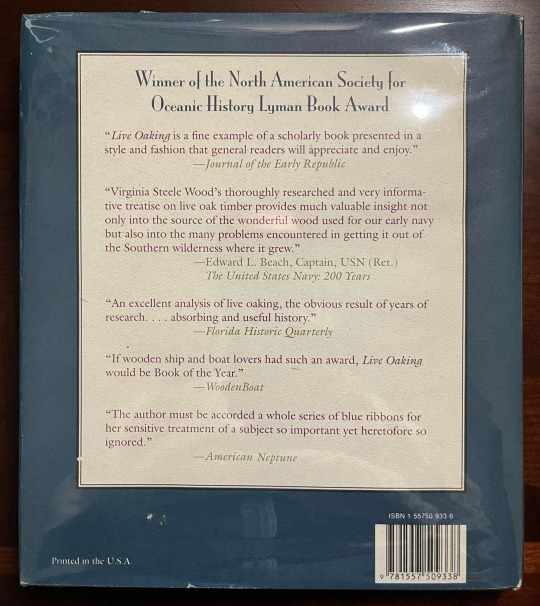

The How
I would say I know, like, a normal amount about wooden ship construction. Sometimes books about such enter one’s awareness and can be had modestly used for modest expense. This isn’t one of those times, though; I paid like $28 for my copy. Sad times.
The Text
So wooden ship construction, right? Calls for great timbers — keels, floors, futtocks of various sorts, stern posts, Sampson posts, bows, knees — among other bits. Live oak is good for those, or was. These days it’s more complicated, but that’s slightly out of scope.
Wood (sensu author) has prepared for us here a good historical account of the live oak trade, and particular live oaking: extraction of the wood (sensu timber) from across southeastern North America, usually by expeditionary crews of shipwrights, carpenters, and slaves. That this is the only real book on the subject — which it is — doesn’t make it good — though it is — but it does make its quirks extra salient.

Quirk #1: Wood (author) uses ‘live oak’ to mean only Quercus virginiana, and implies any other use is a vulgar of the name beyond its proper subject. This is bunk. There are lots of species called the same thing, and I’m not just saying that because I’m a hick. Nor even just because I’m a plant guy, nor from a place with Q. fusiformis as its dominant evergreen oak species, even! Her choice of terms is convenient for the needs of this book, yes, but it’s still bunk.
Quirk #2: Occasionally patriotic? For the needs of this book’s publication, also convenient. Tonally it is bizarre. Apart from two sentences, the book reads as a very straight-laced historical survey. Those spare couple refer to ‘our country’s’ naval power (in the late 18th century) and (of the War of 1812) ‘that regrettable conflict’. I know Warship Guy nostalgia is chronically maladaptive and goofy, but come on.
An interlude here to say the drawings by Walter E. Channing are excellent. He’s the only other author who seems to have treated the subject at all, so appropriate. Warship Guy drafting is chronically clean and good.


Anyway. Quirk #3: The flow of information, while not at all bad, is unpretty. Some ideas and time periods seem to have given themselves easily to thorough research, but others skip by quickly. The later chapters are very thorough indeed, but have very little sense of gravity. The trade in question was vast and the scale of its costs — in labor, in time, in ecological upset — were enormous. This gets lost in the details of daily life that make up the after chapters. The Swift family empire gets a truly good chapter, but that feels like a pet project in a way the others don’t.
Excellent archives work going on here; tons of beautifully relevant original documents have been pulled. The traveling and digging and focus implicated are dumb impressive.

The table to follow is the scariest figure in the whole thing. Hundreds of acres of live oak to build a single 74, and that’s just the frame — no planks, no decks, no rails, no cabins, no masts, no rig, no guns, no furniture, no maintenance — all cut by hand in, say, Georgia or Florida or Louisiana and pulled to, say, Maryland or Massachusetts. Tens of thousands of acres stripped a year for over a century, miles and miles inland from convenient coasts. I wish this did a better job of impressing (ha) that.
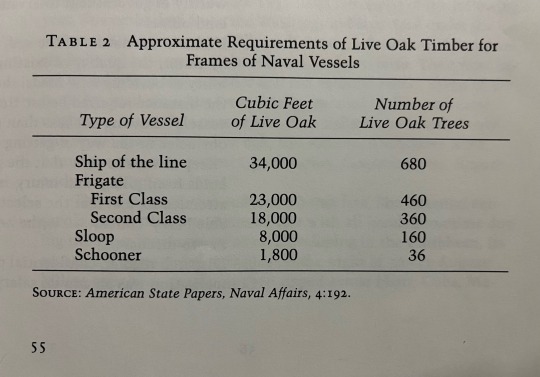
The Object
This copy has suffered somewhat from humidity, but no rough handling. I talk about print quality practically every week, and in this case I can rave. So fucking good. Clean, dark, durable, inert. Scans of period documents are amazing; drawings are amazing. The design work rules. Endpapers are coarse and pleasant. Mentioning Channing’s drawings here again because they’re relevant and I can’t stress enough how legible their spatial aspect is.

The Why, Though?
Having recently moved from [a place with Q. fusiformis as its dominant evergreen oak] to [a place with Q. virginiana as its dominant evergreen oak], the venerable southern live oak is a thing I feel compelled to Know. This is a goofy step toward that, but a step nonetheless.
I’m also excusing this as secret research for a secret project coming down the line sometime between soon and eventually. This contains a song printed (best I can tell, anyway) only once before in 1927, and I wanted it.
28 notes
·
View notes